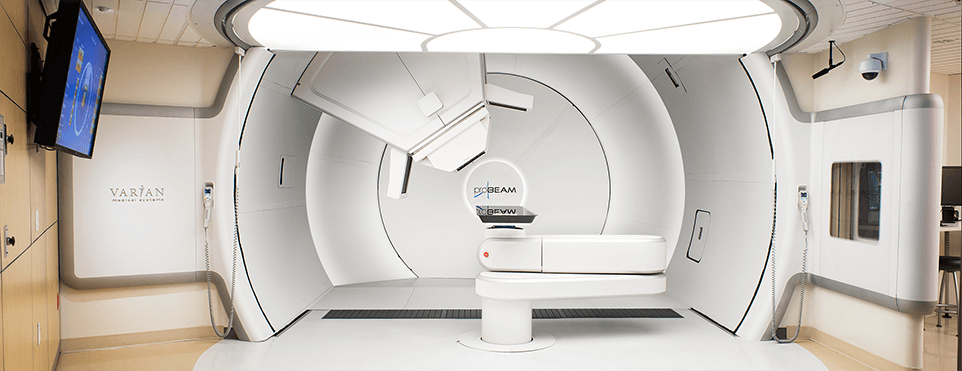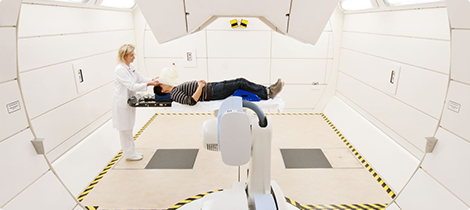Learn more at our Proton Therapy Center site: protherapy.ru
Traditional radiation therapy appeared long time ago and has improved for many years. It is an effective method of treating many types of cancer. However, this radiation therapy come with side effects. Primary photons and secondary electrons release their energy along the beam path. The radiation affects healthy tissues on the way to the tumor and beyond. Such "exit dose" of radiation damages normal cells and can lead to late complications.

Proton therapy is the most precise
method of radiotherapy
The advantage of proton therapy is based on the physical property of protons to deposit most of their energy precisely at the tumor site. As they move through the body, protons slow down, interact with electrons and deposit maximum radiation at the end of their path. The point where the maximum energy is released is called the Bragg peak. Doctors can calculate the Bragg peak in the patient's body so that it would coincide with the center of the cancerous tumor. The proton beam is precisely shaped to conform to the shape and depth of the tumor while sparing the surrounding healthy tissues and organs.
ADVANTAGES OF PROTON THERAPY
Sparing of healthy tissues enables the treatment of tumors near vital organs
Low risk of side effects during and after radiotherapy, and more rapid recovery of patients after the treatment
Reduced risk of cancer recurrence due to high precision targeting
How does it work?
To understand how proton therapy works, let’s have a look at the physical processes taking place inside the proton accelerator, the cyclotron, and the beam transport system.
- Protons originate in the ion source. In a fraction of a second, hydrogen atoms are split into negatively charged electrons and positively charged protons.
- The protons get into the linear accelerator through a vacuum tube, and in just a few microseconds their energy reaches 7 million electron/volts.
- The protons stay in the vacuum tube upon entering the cyclotron where acceleration increases their energy to the values of 70 to 250 million electron/volts, sufficient for delivering the protons to any depth within the patient's body.
- After leaving the cyclotron, the protons move through the beam transport system consisting of a series of magnets that shape, focus and direct the proton beam to a special treatment room.
- The treatment room has a 360° rotational gantry, enabling the beam to enter the patient body from any angle. The beam movement is controlled by powerful computers, and the doctors monitor the course of treatment via their monitors. A multi-tiered safety system protects the patient and staff from radiation exposure.
- Exiting the nozzle, the proton beam is shaped by a special device (aperture), while another device (compensator) directs the beam three-dimensionally to the tumor.
- At its maximum energy the proton beam moves at a speed equivalent to two-thirds of the speed of light
Pencil Beam Scanning

Pencil beam scanning (PBS) is an advanced method of proton therapy currently available in just a few centers in the world. This capability is available at MIBS Proton Therapy Center.
PBS technology is based on complex treatment planning systems and multiple magnets controlling the narrow proton beam, virtually "applying" layer by layer the dose of radiation. The proton beam moves along the vertical and horizontal axes, like a sharp pencil tip "painting" the entire tumor. As it makes its way through the tumor, its intensity is modulated. The maximum dose of radiation is delivered precisely into the cancer cells, while avoiding normal tissues.
Pencil beam scanning is very effective in the treatment of the most complex cancer cases, such as prostate, brain, eye and pediatric tumors. Intensity-modulated proton therapy is most suitable for the delivery of a powerful and accurate dose of radiation to complex or concave tumors located near the spine or inside the head, neck or at the base of the skull.
История
- Proton beam therapy is considered to be a cutting edge method of nuclear medicine in the whole world. But the technology was discovered a long time ago.
- 1946 The idea of using protons in medical treatment was first suggested in 1946 by physicist Robert R. Wilson.
- 1950 The first attempts to use proton radiation for treating patients were made in 1950 in the United States in the Laboratory of Nuclear Studies. But the energy of particle accelerators at the time was not enough to penetrate deep into the body.
- 1970 At the end of the 1970s, the spread of imaging technology along with the development of high-tech computers and advanced accelerators helped adopt proton therapy into clinical practice.
- 2000The wide spread of proton therapy throughout the world began in the beginning of the 2000s.
- Today, there are 57 operating proton therapy centers in the United States, Japan, Germany, Czech Republic, and Russia. It is expected that by 2018 this number will grow to 88.
Who can benefit from proton therapy?

Proton therapy is used to treat many types of cancer in the clinics around the whole world. And often, it is the only solution for the patients.
- First, proton therapy does not require surgery, which makes this method ideal for inoperable tumors. Proton beam treatment is suitable for the patients who for health reasons are not suitable for surgery. Or for those who, for one reason or another, refuse to undergo open surgery.
- Second, high-precision targeting of cancer cells in combination with maximum sparing effect on healthy organs and normal tissues make proton therapy an indispensable method in the cases where the tumor lies dangerously close to vital organs such as the brain, heart, spine.
- Third, proton therapy shows excellent results in treating solid tumors with defined borders, that is, in the cases where the cancer has not spread to other parts of the body.
- Fourth, the sparing of healthy cells and absence of side effects make proton therapy the most suitable method for the treatment of children.
